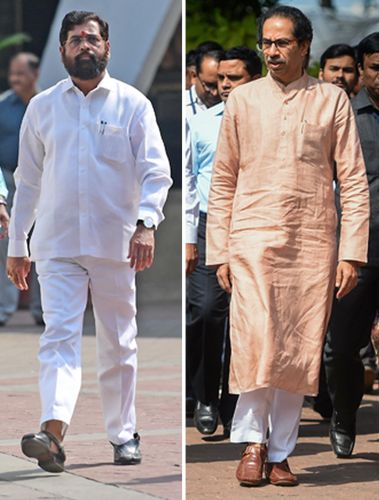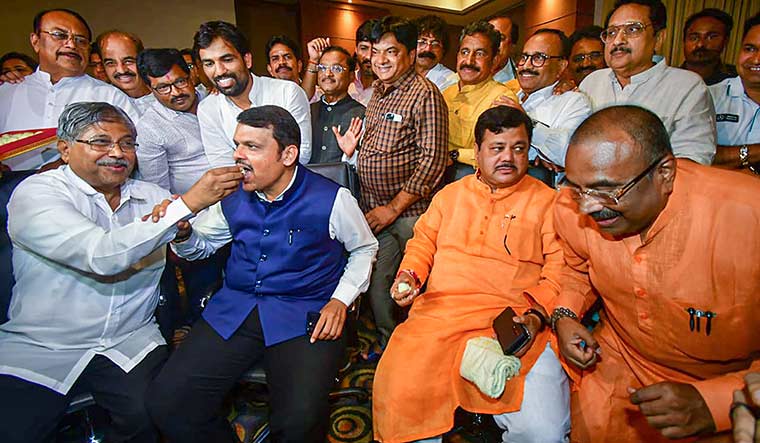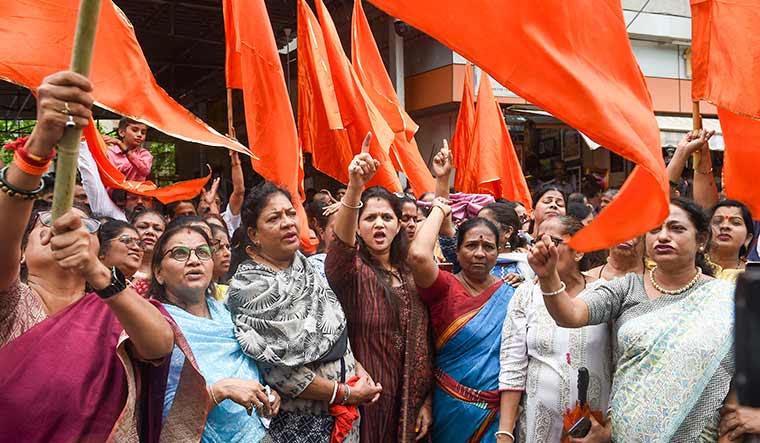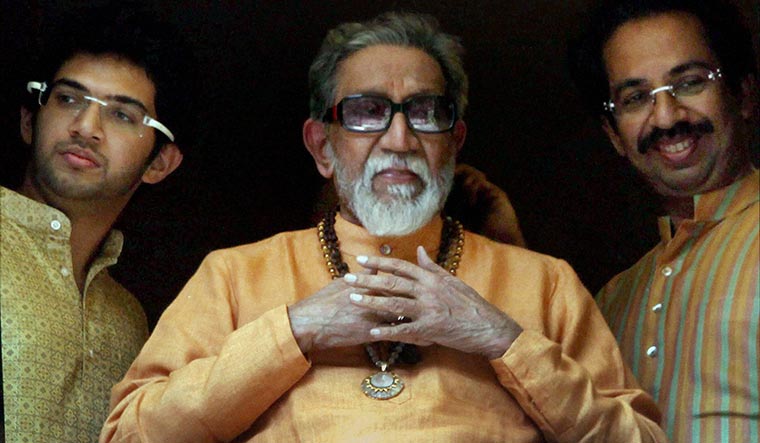The year was 1967. The Shiv Sena, formed just a year earlier, was preparing for the Lok Sabha polls. It had no candidate in the fray, but Balasaheb Thackeray had decided that his party would oppose two south Indians contesting from constituencies in Mumbai—V.K. Krishna Menon and George Fernandes. Menon was contesting as an independent and Fernandes as Samyukta Socialist Party candidate. Balasaheb supported two Congress leaders, S.G. Barve and S.K. Patil, against Menon and Fernandes, respectively.
At that time, the number two man in the Shiv Sena was Balwant Mantri. He had addressed crowds just ahead of Balasaheb at the Sena’s first-ever Dussehra rally in 1966, which made him second in the party hierarchy.
Mantri strongly believed in Balasaheb’s ‘sons of the soil’ cause, but he was temperamentally different. He wanted the Sena to be run on democratic principles. At a meeting in Vanmali Hall in Dadar, he prepared to tell the cadre about the need to run the Shiv Sena as a democratic party.
“Just as his speech was about to begin, a group of Shiv Sainiks rushed to the stage,” writes journalist Prakash Akolkar in Jai Maharashtra, a book on the Sena. “They pulled Mantri aside and began beating him. They tore off his clothes, blackened his face and body, and paraded him from Vanmali Hall to the office of Marmik (the weekly that was the Sena’s mouthpiece before Saamana was launched) in Shivaji Park area. Mantri was thrown at Thackeray’s feet and was made to apologise profusely. That was the day it became clear to the Sainiks that Thackeray’s will be the last word in party matters.”
Fifty-five years since, the Shiv Sena is in the grip of an existential crisis. In June, as many as 39 of the party’s 56 MLAs formed a breakaway group under veteran leader Eknath Shinde. They camped in faraway Guwahati, laying claim to Balasaheb’s political legacy. Uddhav Thackeray, Balasaheb’s son and the current Sena chief, struggling to contain the crisis, implored the rebels to come to the discussion table, so that their grievances could be addressed. “I urge you to do this not just as party chief, but also as the head of the Shiv Sena family,” said Uddhav. Unable to convince them, Uddhav announced his resignation as Maharashtra chief minister on June 29.
Clearly, much has changed since Mantri’s rebellion.
But the battle for the Sena has only begun.
Uddhav’s biggest strength is that he is a Thackeray; his biggest weakness—he is not Balasaheb Thackeray. Uddhav knows this, and that is why Shinde’s hostile takeover bid has not yet resulted in a battle on the streets of Mumbai, Thane and other constituencies represented by the rebel MLAs.
Shinde’s rebellion, which has the BJP’s tacit support, has exposed the clash between two Shiv Senas. On one side is a party that has been trying to shed its hardline hindutva image ever since it joined hands with the Congress and the Nationalist Congress Party to form government in the state. That side wants to be soft and suave, as the baton of leadership gradually changes hands from Uddhav to son Aditya Thackeray. On the other side is the party organisation, which firmly believes in aggression, Maratha pride and hardline hindutva. Aditya represented the gentler side when he said, “I have not harmed anyone and do not wish to. It is good that the dirt (the rebel group) is leaving us on its own.” Sanjay Raut, a staunch supporter of Uddhav, spoke for the aggressive side when he thundered, “Forty bodies will come back from Guwahati.”
The revolt also reveals the urban-rural schism in the Sena. Barring some eight MLAs from the Mumbai-Thane belt, the Shinde group largely represents rural constituencies. Many MLAs who support Shinde have spent much of their lives fighting the Congress and the NCP in their districts. They have been circulating an old speech by Balasaheb, in which he asks the Shiv Sainiks to dump him if he ever takes the Sena close to the Congress.
Shinde is a Sainik groomed by the legendary Anand Dighe. A bachelor and chain smoker, Dighe ran the party machine in Thane district until he died in 2001. Dighe and Balasaheb had a certain understanding—Balasaheb gave Dighe a free hand in Thane; in return, Dighe gave Balasaheb his full support and promised to not expand his sphere of influence beyond Thane. Like Balasaheb, Dighe never contested elections, but wielded great power. He had all Sena corporators in Thane under his thumb, and once even had a few of them thrashed for enjoying the perks of power.
As Dighe’s protege, Shinde was witness to the developments that led to the murder of the Sena’s Thane corporator Shridhar Khopkar in 1989. Khopkar was killed, allegedly by Shiv Sainiks, after he voted for the Congress candidate in a mayoral election. That is the kind of intense dislike for the Congress ideology that Shinde and fellow rebels grew up with.
But, it was still relatively easy for the Shiv Sainiks in the Mumbai-Thane belt to adapt to the Sena’s alliance with the NCP and the Congress. The Sena had been ruling the belt for more than three decades now, with the NCP and the Congress posing little challenge. But that has not been the case in rural areas, where Sena leaders have to fight the Congress and the NCP in almost every election.
The rebel leaders say both Uddhav and Aditya depended heavily on the NCP in running the government. They were also seen to be lacking in determination to realise some of the Sena’s longstanding goals, such as renaming Aurangabad as Sambhajinagar. Uddhav had apparently been delaying a decision on the matter because of pressure from the NCP and the Congress.
Also, Aditya was perceived to be cosying up to the NCP leadership, ignoring protests from Sena MLAs and district-level leaders. An incident in March is said to have immensely hurt three legislators in Raigad district, where Aditya had gone to attend a party meeting. Interestingly, the meeting was held in Shrivardhan, the constituency represented by veteran NCP leader Sunil Tatkare’s daughter and minister of state Aditi Tatkare. There has long been intense rivalry between the Tatkares and the Sena in Raigad politics, but the meeting in Shrivardhan was meant to be a show of newfound unity and strength.
During the meeting, the three Sena MLAs wanted Aditya to look into the NCP’s growing clout in the district, which they felt was coming at the Sena’s expense. But Aditya apparently told them that it was not the platform to air complaints. To make matters worse, he declined an invitation from Sena workers to have lunch with them, and instead chose the lavish spread put together by the Tatkares.
All three MLAs are now with Shinde.
The discontent extends to urban constituencies as well. Sada Sarvankar, who represents Mahim, recently alleged that Jitendra Awhad, NCP leader and housing minister, had repeatedly ignored the difficulties faced by around 5,000 families living in dilapidated buildings. They were facing the threat of relocation, even though most families were Sena supporters. Sarvankar said he had sent almost 50 letters to the party leadership and the government.
“I don’t face any electoral challenge from the NCP or the Congress, but things like this are happening in every Sena constituency,” said Sarvankar. “When you see this pattern, you realise that the NCP is out to finish the Sena. That is why I decided to join the Shinde group.”
Two battles are being fought simultaneously in the Sena’s internal war. One is for taking control of the legislative party; the other is for securing Balasaheb’s legacy and defining the party’s political identity. As the Shinde group has been saying, “We are not leaving the Shiv Sena. We are the Shiv Sena, and we represent the majority.”
Shinde’s hold over the legislative party appears firm. But the same cannot be said of his hold on the party organisation. This became apparent on June 25, when Uddhav called a meeting of the party’s national executive to push through six resolutions. The first one authorised him to take all decisions regarding party affairs, and another resolution barred the rebel group from using Balasaheb’s name.
The party also wrote to Deputy Speaker Narhari Zirwal, requesting him to disqualify 16 rebel MLAs, and appointed Ajay Chaudhari as Shinde’s replacement as the Sena’s legislative party leader. Shinde opposed it saying he had the support of two-thirds of party MLAs, and installed his supporter Bharat Gogawale as party whip, replacing Uddhav supporter Sunil Prabhu.
The Shinde group also challenged in the Supreme Court the disqualification notices issued by the deputy speaker. It told the court that the Maha Vikas Aghadi (MVA) government led by Uddhav was in the minority, since the Shinde group had withdrawn support to the coalition. A no-confidence motion against Zirwal has also been filed in the legislature secretariat.
On June 27, the Supreme Court said the rebel MLAs cannot be disqualified till July 12. It denied the MVA’s plea to stop a floor test in the assembly, saying it was free to move court if there were illegalities in the test. A triumphant Shinde group described the interim order as a victory for Balasaheb and Dighe’s thoughts.
“Akher Mahashaktila prakat vhavech lagle (Finally, the big power had to make an appearance),” tweeted Congress leader Sachin Sawant on the night of June 28, as BJP leader and former chief minister Devendra Fadnavis rushed to the Raj Bhavan with his party colleagues soon after it became known that Governor B.S. Koshyari had recovered from Covid.
Fadnavis had met Union Home Minister Amit Shah and BJP president J.P. Nadda in Delhi, and his team soon briefed the governor about the developments in the state. Koshyari was told that Uddhav needed to prove majority on the floor of the house as soon as possible.
The BJP had, until then, been on the sidelines of the high drama. Fadnavis’s offensive, launched after instructions from the party’s top brass, lent credence to the MVA’s suspicions that it was the BJP that had triggered the crisis. NCP chief Sharad Pawar told THE WEEK that the entire drama was nothing but “Operation Lotus” (interview on page 32).
Surprisingly, Deputy Chief Minister Ajit Pawar and Irrigation Minister Jayant Patil, both of whom belonged to the NCP, said the BJP was not involved in the Sena’s internal fight. Sharad Pawar soon dismissed their statements. “Ajit knows only the developments that are happening in the state,” he said. “I know what is going on in the country. The rebels could not have gone to Surat without help from the BJP’s Gujarat unit president C.R. Patil. I know him as he is a member of Parliament.”
Clearly, the BJP was keeping radio silence. The party’s state core committee had taken stock of the situation on June 27, but journalists were only told that the party had decided to “wait and watch”.
As BJP leaders emerged from Raj Bhavan, they sensed that the target was in the crosshairs. On June 29, the governor asked the assembly to convene a special session to conduct a floor test the following morning. The MVA again moved the Supreme Court requesting an urgent hearing, saying the governor’s move was “arbitrary and motivated”. The court agreed to the urgent hearing, but refused to stay the floor test. It also said the result of the floor test would depend on “the final outcome” of the related cases before it.
Uddhav by then was in full retreat. Hours before the court’s interim order on the floor test came, he convened a farewell cabinet meeting. He told the ministers that the MVA government had done good work, and that the allies would continue to work together. He apologised for any hurt he had caused through his words or actions. In what seemed to be an effort to preserve his hindutva credentials, he ordered the renaming of Aurangabad as Sambhajinagar and Osmanabad as Dharashiv. Finally, minutes after the Supreme Court decided not to stay the floor test, Uddhav announced that he was stepping down as chief minister. All through the crisis, he had maintained that he was against facing a floor test in the assembly.
The BJP had its Plan B ready, just in case things had not turned out the way it did. The party had decided to launch an all-out offensive to defeat Uddhav in the Brihanmumbai Municipal Corporation elections later this year. Once Sena loses control of the BMC, the BJP calculated, its resources and funds would start drying up, leading to further defections.
“The BJP wants the Sena’s cadre, and its corporators and MLAs and MPs, but not the Thackerays,” said Akolkar. “They want to make Thackeray politically irrelevant.”
“Gandit golya ghala salyanchya (Shoot the rascals in their arses),” an angry Shiv Sainik from Mumbai told a close aide of Uddhav after a party meeting at the Shiv Sena Bhavan.
The sentiment in Thane, Shinde’s bastion, is different, though. More than anger, it is the shock that is palpable. “On that evening [when Shinde rebelled], I had no words to express myself in front of the Shiv Sainiks in our shakha,” said a Shiv Sena leader in Thane. “For me, Uddhav ji is saheb (boss), and so is Eknath Shinde. Since I am from Thane, I am more in touch with Shinde, as he is available for us any hour of the day. We, the Shiv Sainiks in Thane and Palghar districts, will be totally sandwiched in this battle.”
The vast network of foot soldiers like him has been the Sena’s core strength. Ever since the crisis started, support for Uddhav had been pouring in from across Maharashtra. But whether it would continue remains to be seen.
A senior Congress leader said sharing the opposition space with the Sena would be more comfortable for the Congress. “The Sena has cadre. They may have taken a huge blow right now, but they will recover,” said the leader. “There would be limitations on how the Sena could hit back. But if we become the opposition, the Sena leadership could let loose all the fury of the Sainiks. The Congress and the NCP cannot enforce a ‘Maharashtra Bandh’, but the Sena easily can.”
The Thackerays and their loyalists are taking all steps to secure the party’s name and its symbol—the bow and arrow. Uddhav has asked Aditya to take charge of the coming battle. Aditya will start touring the state and reach out to the Shiv Sainiks and the voters.
It was the angst and pride of lower- and middle-class Maharashtrians that birthed the Shiv Sena. The angst may have softened a bit, owing to Maharashtra’s economic progress over the decades, but the pride (or Marathi asmita, as Shiv Sainiks like to call it) is as potent as ever.
It was the Sena’s pride that went before Uddhav’s fall. In every Sena meeting now, the rebels are portrayed as traitors who let it happen. “The dirt has gone,” said Aditya in a recent meeting. “Let us rebuild the party from scratch and we will have fresh faces ready to take them on in the upcoming polls. Let us make sure none of the traitors return to the legislative assembly.”
For now, though, the Thackeray scion will have to keep aside his soft, suave and stylish persona. He will have to lead aggressively from the front, as Uddhav is battling health problems. If he fails, Aditya faces a familiar threat in Indian politics—of becoming just another also-ran dynast.







